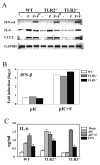Theiler's virus infection induces TLR3-dependent upregulation of TLR2 critical for proinflammatory cytokine production
- PMID: 19191335
- PMCID: PMC2706926
- DOI: 10.1002/glia.20843
Theiler's virus infection induces TLR3-dependent upregulation of TLR2 critical for proinflammatory cytokine production
Abstract
Theiler's murine encephalomyelitis virus (TMEV) infection directly induces many proinflammatory genes, including type I interferon (IFN) and a variety of cytokine genes. These virus-induced cytokines are a critical factor in developing TMEV-induced demyelinating disease. We have previously reported that the major activation signal for the cytokine genes is mediated via TLR3. In this study, we describe that TLR2 is upregulated via TLR3 signal and cooperatively participates in the expression of IL-6, IL-1beta, CCL2, and CCL5 genes following TMEV infection. The expression of these genes was significantly impaired in both TLR2-deficient and TLR3-deficient primary astrocytes. However, the induction of type I IFNs was not affected by TLR2 deficiency in the primary cells. TMEV infection led to TLR2-mediated NF-kappaB activation, but not IRF3 or IRF7 activation, critical for type I IFN production. More importantly, TLR3 was required for TMEV-induced early TLR2 upregulation in primary astrocytes leading to the production of TLR2-dependent cytokines such as IL-6. Interestingly, soluble factor(s) produced via TLR2/3-dependent signals appears to be partially associated with the downstream cytokine production. These results indicate that TMEV utilizes TLR3-induced TLR2 to induce inflammatory cytokines, which are critical to the development of immune-mediated demyelinating disease.
Figures







References
-
- Akira S. TLR signaling. Curr Top Microbiol Immunol. 2006;311:1–16. - PubMed
-
- Akira S, Hemmi H. Recognition of pathogen-associated molecular patterns by TLR family. Immunol Lett. 2003;85:85–95. - PubMed
-
- Aravalli RN, Hu S, Rowen TN, Palmquist JM, Lokensgard JR. TLR2-mediated proinflammatory cytokine and chemokine production by microglial cells in response to herpes simplex virus. J Immunol. 2005;175:4189–93. - PubMed
-
- Asea A, Rehli M, Kabingu E, Boch JA, Bare O, Auron PE, Stevenson MA, Calderwood SK. Novel signal transduction pathway utilized by extracellular HSP70: role of toll-like receptor (TLR) 2 and TLR4. J Biol Chem. 2002;277:15028–34. - PubMed
Publication types
MeSH terms
Substances
Grants and funding
LinkOut - more resources
Full Text Sources
Molecular Biology Databases

